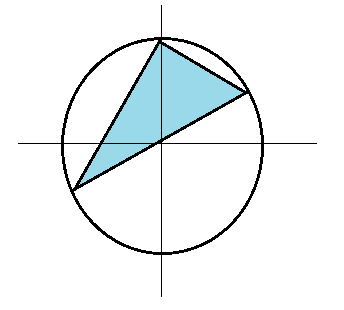Two Thetas Make a Triangle

Consider three points on the unit circle in the x y plane:
P 1 P 2 P 3 = ( 0 , 1 ) = ( cos θ 1 , sin θ 1 ) = ( cos θ 2 , sin θ 2 )
Angles θ 1 and θ 2 are randomly and uniformly distributed between 0 and 2 π . If these three points are the vertices of a triangle, what is the triangle's expected area?
The answer is 0.477.
This section requires Javascript.
You are seeing this because something didn't load right. We suggest you, (a) try
refreshing the page, (b) enabling javascript if it is disabled on your browser and,
finally, (c)
loading the
non-javascript version of this page
. We're sorry about the hassle.
1 solution
But is there no other way of doing it? The topic of the question is calculus
Continuing without code we would have to calculate an integral.
Let x = ( α , β ) ∈ [ 0 , 2 π ] × [ 0 , 2 π ] = D then E [ A ] = ∫ D A ( x ) f ( x ) d x sice we are choosing a point uniformly at random from a square of side 2 π the probability dencity function is just f ( x ) = 4 π 2 1 hence our integral is E [ A ] = ∫ 0 2 π ∫ 0 2 π 8 π 2 ∣ cos ( α ) + sin ( β − α ) − cos ( β ) ∣ d α d β = 2 π 3 ≈ 0 . 4 7 7
The code above is actually solving this integral numerically in a pretty weird way :)
Log in to reply
Is there some way to remove mod from this integral? I tried integrating α from 0 → β and switching one factor of 2 π → β but that gave 0.306 as answer
Log in to reply
Yes, there is. The sign of det ( P 1 , P 2 ) depends on the orientation of the vectors P 1 and P 2 the problem is that I made a poor choice on the parametrization if one want to solve by hand. My angles α and beta β are measured from the point ( 0 , 1 ) and not from the origin. It would be better to use:
P 1 = ( sin ( α ) , 1 − cos ( α ) )
P 2 = ( sin ( β ) , 1 − cos ( β ) )
In this way det ( P 1 , P 2 ) = sin ( α ) − sin ( α − β ) − sin ( β ) > 0 exactly when α > β since the angles coincide with the directions of the vectors. Finally since the integral is simmetrical on both triangles (of the α β -square) it reduces to
E [ A ] = ∫ 0 2 π ∫ 0 2 π 8 π 2 ∣ sin ( α ) − sin ( α − β ) − sin ( β ) ∣ d β d α = 2 ∫ 0 2 π ∫ α 2 π 8 π 2 sin ( α ) − sin ( α − β ) − sin ( β ) d β d α = 2 π 3 ≈ 0 . 4 7 7
P 1 = ( cos ( α ) , 1 + sin ( α ) )
P 2 = ( cos ( β ) , 1 + sin ( β ) )
for the randomly and uniformly distributed angles α , β ∈ [ 0 , 2 π ] . With this conventions, the area of the triangle is given by
A = 2 1 ∣ det ( P 1 , P 2 ) ∣ = 2 1 ∣ cos ( α ) + sin ( β − α ) − cos ( β ) ∣
from here I write some code and estimated the expected area throughout the mean A ≈ 0 . 4 7 7